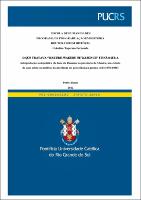| Share record |


|
Please use this identifier to cite or link to this item:
https://tede2.pucrs.br/tede2/handle/tede/10220Full metadata record
| DC Field | Value | Language |
|---|---|---|
| dc.creator | Fernando, Celestino Taperero | - |
| dc.contributor.advisor1 | Paredes, Marçal de Menezes | - |
| dc.date.accessioned | 2022-05-12T18:09:26Z | - |
| dc.date.issued | 2022-04-25 | - |
| dc.identifier.uri | https://tede2.pucrs.br/tede2/handle/tede/10220 | - |
| dc.description.resumo | Este trabalho trata sobre a interpretação sociopolítica da base da Renamo na província de Manica, habitada por grupo étnico Shona subdivido em pequenas tribos durante o contexto da guerra civil em Moçambique. Toma-se por base relatos dos atores da base, com destaque a guerrilheiros, mudjibas, mambos e à população que vivia nas zonas sob jurisdição da RENAMO. Faz-se o cruzamento desse material com a historiografia já existente para apurar qual era o sentimento político-moral do grupo a respeito da guerra civil. Com a evolução da guerra em Moçambique, a RENAMO deixa de se definir apenas como um movimento de guerrilha e passa a ser estruturada como partido político, para internacionalizar-se e também tentar limpar sua imagem de “bandidos armados”. Neste contexto, o trabalho foi concebido na base de fontes orais e escritas. Coletamos as fontes orais a partir de entrevistas realizadas com intervenientes que não pertenciam à elite dos movimentos, como os guerrilheiros, mudjibas e a população da RENAMO. Em relação às fontes escritas, conectamos a velha e a nova interpretação sobre a origem da resistência armada em Moçambique. A partir de tais fontes, pudemos mapear a área de investigação, o que facilitou a compreensão de conceitos como bandidos armados, Homem Novo, inimigo, cooperativa e aldeias comunais, para a construção de nosso entendimento sobre o sentimento da população em um recorte temporal entre 1976 e 1986. As entrevistas com a base da RENAMO demonstraram o distanciamento das diferentes interpretações dos historiadores sobre a RENAMO. | por |
| dc.description.abstract | The work deals with the socio-political interpretation of the Renamo base in Manica province inhabited by the Shona ethnic group subdivided into small tribes during the context of the civil war in Mozambique. Based on reports from the base actors, with emphasis on guerrillas, mudjibas, mambos and the population that lived in areas under Renamo’s jurisdiction. This material is crossed with the historiography that already exists to determine what the political-moral sentiment of the group was about the civil war. With the evolution of the war in Mozambique, Renamo ceased to be defined only as a guerrilla movement and started to be structured as a political party, in order to be able to internationalize and also try to clean up its image of armed band its. In this context, the work was conceived on the basis of two sources, oral sources that it was possible to interview the actors who did not belong to the elite of the movements such as the guerrillas, mudjibas and the Renamo population and in the written sources we connect the old and the new interpretation. on the origin of armed resistance in Mozambique. It was on the basis of them that we were able to map the research area, which also facilitated the understanding of concepts such as: armed bandits, new man, enemy, cooperative and communal villages for the construction of our understanding of population sentiment in a time frame between 1976 and 1986. The interviews with the Renamo base demonstrated the distance from the different interpretations of historians about Renamo. | eng |
| dc.description.provenance | Submitted by PPG História ([email protected]) on 2022-05-12T14:20:29Z No. of bitstreams: 1 CELESTINO_TAPERERO_FERNANDO_TES.pdf: 3985080 bytes, checksum: 378c7b0002c0b735e1f452b3fab711f4 (MD5) | eng |
| dc.description.provenance | Approved for entry into archive by Sheila Dias ([email protected]) on 2022-05-12T17:47:59Z (GMT) No. of bitstreams: 1 CELESTINO_TAPERERO_FERNANDO_TES.pdf: 3985080 bytes, checksum: 378c7b0002c0b735e1f452b3fab711f4 (MD5) | eng |
| dc.description.provenance | Made available in DSpace on 2022-05-12T18:09:26Z (GMT). No. of bitstreams: 1 CELESTINO_TAPERERO_FERNANDO_TES.pdf: 3985080 bytes, checksum: 378c7b0002c0b735e1f452b3fab711f4 (MD5) Previous issue date: 2022-04-25 | eng |
| dc.description.sponsorship | Conselho Nacional de Pesquisa e Desenvolvimento Científico e Tecnológico - CNPq | por |
| dc.format | application/pdf | * |
| dc.thumbnail.url | https://tede2.pucrs.br/tede2/retrieve/184030/TES_CELESTINO_TAPERERO_FERNANDO_CONFIDENCIAL.pdf.jpg | * |
| dc.thumbnail.url | https://tede2.pucrs.br/tede2/retrieve/187569/TES_CELESTINO_TAPERERO_FERNANDO_COMPLETO.pdf.jpg | * |
| dc.language | por | por |
| dc.publisher | Pontifícia Universidade Católica do Rio Grande do Sul | por |
| dc.publisher.department | Escola de Humanidades | por |
| dc.publisher.country | Brasil | por |
| dc.publisher.initials | PUCRS | por |
| dc.publisher.program | Programa de Pós-Graduação em História | por |
| dc.rights | Acesso Aberto | por |
| dc.subject | RENAMO | por |
| dc.subject | Manica | por |
| dc.subject | Resistência | por |
| dc.subject | Moçambique | por |
| dc.subject | Aldeias Comunais | por |
| dc.subject | Renamo | eng |
| dc.subject | Manica | eng |
| dc.subject | Resistance | eng |
| dc.subject | Mozambique | eng |
| dc.subject | Villages | eng |
| dc.subject.cnpq | CIENCIAS HUMANAS::HISTORIA | por |
| dc.title | O que tratava “Wakuru-Wakuru Ne Wazungu” eu não sei : a interpretação sociopolítica da base da Renamo na província de Manica, um estudo de caso sobre os motivos da aderência do povo Shona à guerra civil (1976-1986) | por |
| dc.type | Tese | por |
| dc.restricao.situacao | Trabalho será publicado como artigo ou livro | por |
| dc.restricao.prazo | 12 meses | por |
| dc.restricao.dataliberacao | 12/05/2023 | por |
| Appears in Collections: | Programa de Pós-Graduação em História | |
Files in This Item:
| File | Description | Size | Format | |
|---|---|---|---|---|
| TES_CELESTINO_TAPERERO_FERNANDO_COMPLETO.pdf | CELESTINO_TAPERERO_FERNANDO_TES | 3.89 MB | Adobe PDF |  Download/Open Preview |
Items in DSpace are protected by copyright, with all rights reserved, unless otherwise indicated.




